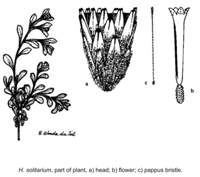Origin of name:
solitarius = alone by itself, solitary
Diagnostic characters:
Leaves spoon-shapedHeads solitary
Description:
Delicate perennial herb, probably mat-forming, branches filiform, prostrate or diffuse, 80-100 mm long, thinly and loosely woolly, young parts leafy. Leaves 5-7 x 1.5-2 mm, spathulate, apex subacute, base much narrowed, half-clasping, both surfaces loosely greyish-white woolly. Heads homogamous, cylindric, 4 x 3 mm, solitary at the branchlet tips, overtopped by leaves. Involucral bracts in 4 series, graded, woolly on backs, outer loosely webbed to 2 adjacent leaves, inner scarcely exceeding flowers, not radiating, tips truncate, emarginate, opaque, pale buff, opaque patch extending briefly down midline. Receptacle shortly honeycombed. Flowers c. 18-20. Achenes not seen, ovaries with myxogenic duplex hairs. Pappus bristles many, probably biseriate (material young), about equaling corolla, scabrid, bases scarcely cohering by minute patent cilia.
Distribution:
On the south-east slopes of Bokkeveld Tafelberg in the Ceres division.
Fynbos Biome.
Notes:
Known only from the type collection.
Taxonomy:
Literature:
Helichrysum solitarium Hilliard in Flora of southern Africa 33,7 (2): 149 (1983).
Type:
Western Cape, Ceres div., Bokkeveld Tafelberg, SE. slopes, in shade, 6 000 ft, 8 xii 1940, Esterhuysen 3934 (BOL, holo.).
Synonym(s):
Vouchers:

